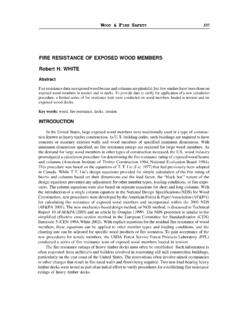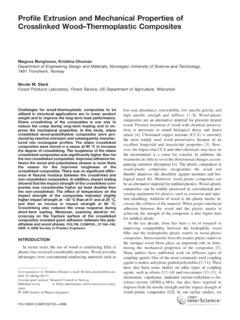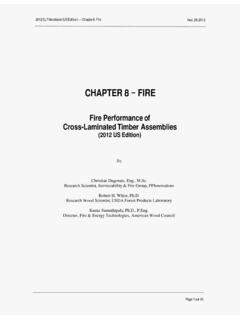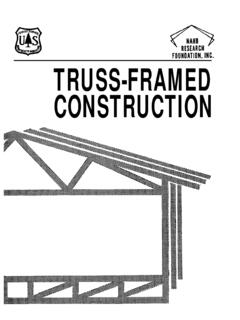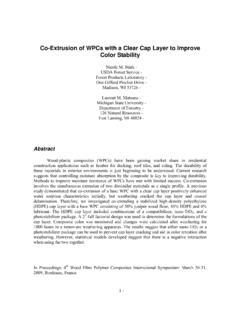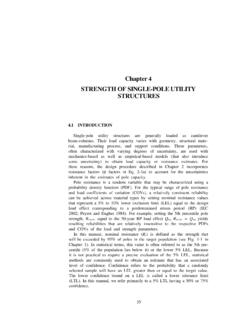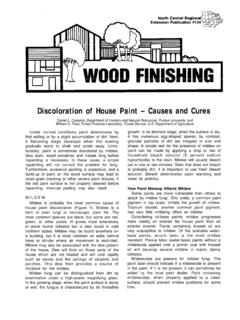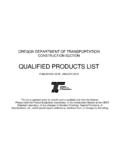Transcription of Wood Handbook, Chapter 15: Wood Preservation
1 Chapter 15 Wood PreservationStan T. Lebow, Research Forest Products Technologist15 1 Contents Wood Preservatives 15 1 Waterborne Preservatives 15 3 Preservatives with ICC ES Evaluation Reports 15 9 Oil-Borne or Oil-Type Preservatives 15 10 Treatments for Wood Composites 15 12 water - repellent and Nonpressure Treatments 15 12 Selecting Preservatives 15 12 Evaluating New Preservatives 15 13 Preservative Effectiveness 15 13 Effect of Species on Penetration 15 15 Preparation of Wood for Treatment 15 15 Peeling
2 15 15 Drying 15 16 Conditioning of Green Products 15 17 Incising 15 17 Cutting and Framing 15 18 Application of Preservatives 15 18 Pressure Processes 15 18 Effect on Mechanical Properties 15 20 Nonpressure Processes 15 20 In-Place and Remedial Treatments 15 22 Best Management Practices 15 23 Quality Assurance for Treated Wood 15 25 Treating Conditions and Specifications 15 25 Inspection of Treatment Quality 15 25 Effects on the Environment 15 26 Recycling and Disposal of Treated Wood 15 26 References 15 27 Many commonly used wood species can deteriorate if ex-posed to conditions that support growth of wood-degrading organisms (see Chap.)
3 14). Wood products can be protected from the attack of decay fungi, harmful insects, or marine borers by applying chemical preservatives. Preservative treatments greatly increase the life of wood structures, thus reducing replacement costs and allowing more efficient use of forest resources. The degree of protection achieved depends on the preservative used and the proper penetration and retention of the chemicals. Some preservatives are more effective than others, and some are more adaptable to certain use requirements. To obtain long-term effectiveness, ad-equate penetration and retention are needed for each wood species, chemical preservative, and treatment method.
4 Not only are different methods of treating wood available, but treatability varies among wood species particularly their heartwood, which generally resists preservative treatment more than does sapwood. Although some tree species pos-sess naturally occurring resistance to decay and insects (see Chap. 14), many are in short supply or are not grown in ready proximity to considering preservative treatment processes and wood species, the combination must provide the required protec-tion for the conditions of exposure and life of the structure. All these factors are considered by the consensus techni-cal committees in setting reference levels required by the American Wood Protection Association (AWPA, formerly American Wood-Preservers Association)) and ASTM Inter-national (formerly American Society for Testing and Materi-als).
5 Details are discussed later in this Chapter . The charac-teristics, appropriate uses, and availability of preservative formulations may have changed after preparation of this Chapter . For the most current information on preservative formulations, the reader is encouraged to contact the appro-priate regulatory agencies, standardization organizations, or trade associations. Note that mention of a chemical in this Chapter does not constitute a PreservativesWood preservatives must meet two broad criteria: (1) They must provide the desired wood protection in the intended end use, and (2) they must do so without presenting unrea-sonable risks to people or the environment.
6 Because wood preservatives are considered to be a type of pesticide, the Environmental Protection Agency (EPA) is responsible for their regulation. Federal law requires that before selling or distributing a preservative in the United States, 15 2a company must obtain registration from EPA. Before registering a new pesticide or new use for a registered preservative, EPA must first ensure that the preservative can be used with a reasonable certainty of no harm to human health and without posing un-reasonable risks to the environment. To make such determinations, EPA requires more than 100 different scien-tific studies and tests from applicants.
7 This Chapter discusses only wood pre-servatives registered by the preservatives are classified as restricted use by the EPA and these can be used only in certain applica-tions and can be applied only by certi-fied pesticide applicators. Restricted use refers to the chemical preservative and not to the treated wood prod-uct. The general consumer may buy and use wood products treated with restricted-use pesticides; EPA does not consider treated wood a toxic substance nor is it regulated as a pes-ticide. Although treated wood is not regulated as pesticide, there are limita-tions on how some types of treated wood should be used.
8 Consumer In-formation Sheets (EPA-approved) are available from retailers of creosote-, pentachlorophenol-, and inorganic-arsenical-treated wood products. The sheets provide information about the preservative and the use and disposal of treated-wood products (see Syn-opsis of EPA-Approved Consumer Information Sheets for Wood Treated with CCA, ACZA, Creosote, or Pen-tachlorophenol). The commercial wood treater is bound by the EPA regulation and can treat wood only for an end use that is allowed for that preservative. Some preservatives that are not classified as restricted by EPA are available to the general consumer for nonpressure treatments.
9 It is the responsibility of the end user to apply these preservatives in a manner that is consistent with the EPA-approved la-beling. Registration of preservatives is under constant review by the EPA, and a responsible State or Federal agency should be consulted as to the current status of any of EPA-approved consumer information sheets for wood treated with CCA, ACZA, creosote, or pentachlorophenolNOTE: This is only a synopsis of information contained in consumer information sheets. For complete consumer information sheets, contact your treated wood supplier or the website of the Environmental Protection PrecautionsAvoid frequent or prolonged inhalation of sawdust from treated wood.
10 When sawing, sanding, and machining treated wood, wear a dust mask. Whenever possible, these operations should be performed outdoors to avoid indoor accumulations of airborne sawdust from treated wood. When power-sawing and machining, wear goggles to protect eyes from flying particles. Wear gloves when working with the wood. After working with the wood, and before eating, drinking, toileting, and use of tobacco products, wash exposed areas thoroughly. Avoid frequent or prolonged skin contact with creosote- or pentachlorophenol-treated wood. When handling creosote- or pen-tachlorophenol-treated wood, wear long-sleeved shirts and long pants and use gloves impervious to the chemicals (for example, gloves that are vinyl coated).
